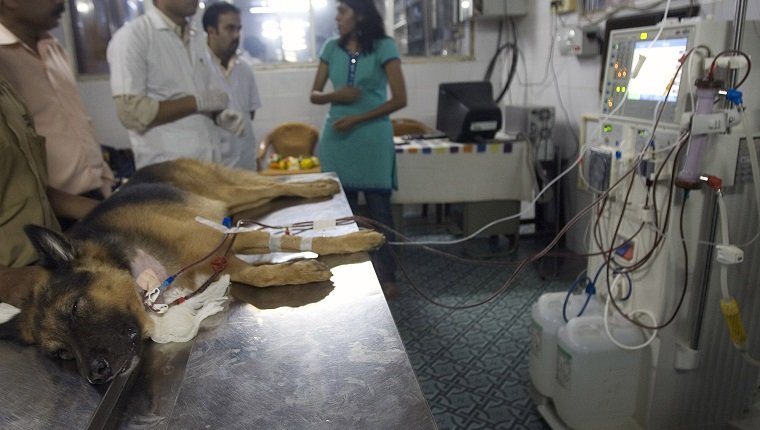Ethylene glycol toxicity in dogs, or antifreeze poisoning, happens when dogs consume the odorless, sweet-tasting ingredient ethylene glycol, commonly found antifreeze.
While antifreeze is the most common substance that causes the condition, ethylene glycol can also be found in windshield de-icers, brake fluid, motor oils, paints, wood stains, inks, printer cartridges, and more.
This is a serious condition, and dogs only need to consume about a half a teaspoon of ethylene glycol per pound of body weight for it to be fatal. It’s more common in fall and winter months when antifreeze is used in cars, as it’s sometimes left out, spills on the ground, or leaks from cars.
Despite its bright color, antifreeze may be hard to spot when it gets covered in snow or slush. It’s especially important in winter months to watch for the symptoms of ethylene glycol toxicity in dogs.
If you see the signs of the condition in your dog, call the ASPCA pet poison hotline at (888) 426-4435 or consult an emergency veterinarian immediately so they can begin treatment. Here’s what you should know about the symptoms, causes, and treatments for ethylene glycol toxicity in dogs.
Symptoms Of Ethylene Glycol Toxicity In Dogs

The symptoms of ethylene glycol toxicity in dogs come in three stages that get progressively worse the longer an affected dog goes without treatment. Symptoms of the first stage of ethylene glycol toxicity in dogs appear within 30 minutes of ingestion.
If you see any of the following first stage signs, it’s important that you provide immediate medical attention for your dog:
- Lethargy
- Vomiting
- Loss of coordination
- Excessive thirst and urination
- Hypothermia
- Rapid eye movements
- Muscle twitches
- Head tremors
- Decreased reflexes
- Seizures
The symptoms of the second stage of ethylene glycol toxicity can be deceptive, as a dog’s condition may seem to improve during this time, even though the situation is becoming more dire.
The following second stage symptoms can appear within twelve to 24 hours of consuming ethylene glycol:
- Dehydration (urination continues but thirst and drinking stop)
- Rapid breathing
- Tachycardia (increased heart rate)
The symptoms of the third stage of ethylene glycol toxicity occur within 36 to 72 hours after consuming the substance. Without treatment, permanent organ damage or death may occur.
Here are the final symptoms of the condition:
- Kidney dysfunction
- Painful kidneys
- Drooling
- Decreased urination or no urination at all
- Coma
- Continued seizures
- Death
Causes Of Ethylene Glycol Toxicity In Dogs

The most common cause of ethylene glycol toxicity in dogs is ingestion of antifreeze, though ethylene glycol is present in several other substances, including many paints, stains, inks, brake fluid, motor oils, and more.
When these substances are left out where dogs can get them or when spills aren’t cleaned up, dogs may be attracted to the sweet taste.
Treatments For Ethylene Glycol Toxicity In Dogs

Treatment for ethylene glycol toxicity in dogs may not require hospitalization if it begins within five hours of ingestion. Intravenous fluids may be given to decrease the risk of dehydration and promote urination, which can help eliminate the substance from the body.
Bicarbonate may be given to reduce metabolic acidosis, a condition where toxins cause the body’s pH level to fall too low. The goal of this treatment is to eliminate ethylene glycol from the body before it can cause significant damage.
If more time has elapsed since ingestion, toxins in the body may build up and cause kidney failure. If that’s the case, then it means that the body has absorbed too much ethylene glycol for direct treatment to be effective. Treatment at that point aims at reducing symptoms.
This treatment will focus on correcting fluid imbalances and electrolytes, as well as reducing the effects of acidosis. Medication may be given to increase urine production. Dialysis may also be needed to filter waste from the blood.
It may take weeks of treatment before kidney function returns to normal.
How do you protect your dog from antifreeze poisoning in winter months? Do you have any tips for other pet parents? Let us know in the comments below!









